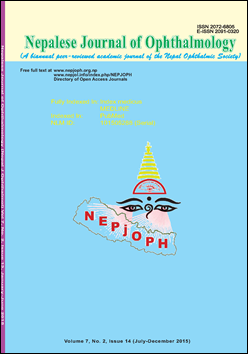Management of childhood glaucoma in Sturge Weber Syndrome: A challenge
DOI:
https://doi.org/10.3126/nepjoph.v7i2.14979Keywords:
Sturge-Weber syndrome, glaucoma, choroidal effusion, trabeculectomyAbstract
Background: Sturge-Weber syndrome (SWS) is a rare congenital neuro- oculo- cutaneous disorder. Glaucoma is one of the ocular abnormalities associated with it. Management of glaucoma in SWS is challenging.
Objective: To report surgical and visual outcome of trabeculectomy in bilateral glaucoma in Sturge-Weber syndrome and the challenges encountered in its management.
Case description: A six-year-old girl presented with gradually progressive increase in size of both the eyes associated with watering, photophobia and diminution of vision since birth. On examination she was diagnosed to have bilateral SWS with glaucoma, refractive to antiglaucoma medications. She underwent trabeculectomy with intraoperative use of 5- FU. The post operative period was complicated with choroidal effusion in both the eyes with shallow anterior chamber. In the second post operative day, the right eye anterior chamber re- formation was done with ringer lactate solution. There was spontaneous resolution of choroidal effusion with normalization of intraocular pressure with no adverse effect on visual acuity within one week.
Conclusion: Treatment of glaucoma associated with Sturge-Weber syndrome is challenging. When planning surgical intervention an increased risk of choroidal effusion associated with it, should be kept in mind.
Downloads
Downloads
Published
How to Cite
Issue
Section
License
This license enables reusers to copy and distribute the material in any medium or format in unadapted form only, for noncommercial purposes only, and only so long as attribution is given to the creator.




